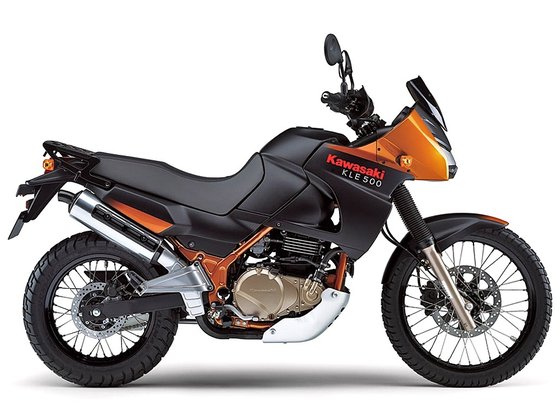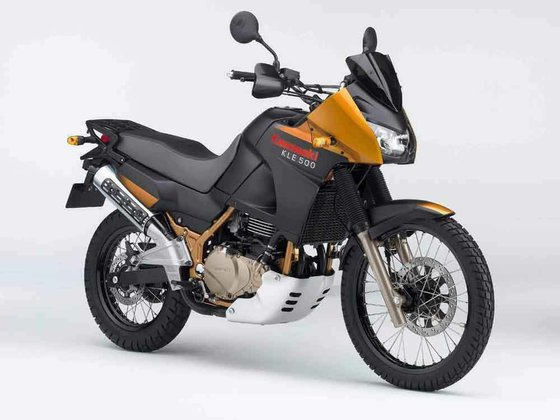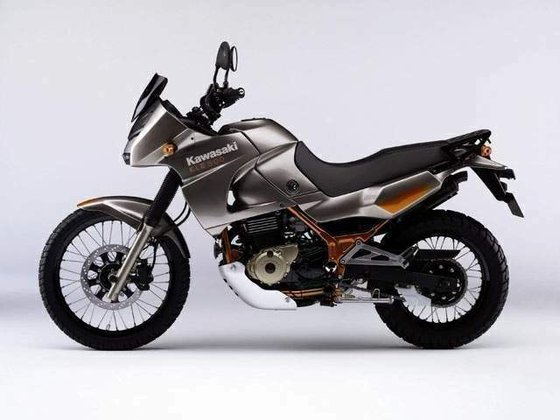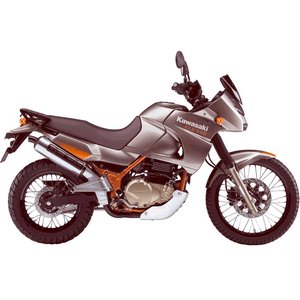Kawasaki KLE 500 (2005-2007): A Dual-Sport Charmer That Plays It Safe

Introduction
The Kawasaki KLE 500 occupies a unique niche in the dual-sport world. Produced from 2005 to 2007, this parallel-twin adventurer was never about raw power or cutting-edge tech. Instead, it carved its identity as a friendly, approachable machine for riders who wanted a taste of off-road capability without sacrificing road manners. Built on Kawasaki’s decades-old ER500 engine platform, the KLE 500 prioritizes reliability and ease of use over adrenaline-pumping performance. But does that make it a forgotten gem or a relic in today’s ADV landscape? Let’s throttle into the details.
Design & Ergonomics: Form Follows Function (With a Dash of Flair)

Kawasaki took a “less is more” approach with the KLE 500’s design, but it’s far from bland. The gold-painted double-cradle steel frame isn’t just structural—it’s a styling statement, contrasting sharply against the matte black bodywork. The 21-inch front wheel and high-mounted exhaust scream “adventure,” while the semi-faired front end with its Z750S-inspired mini-windshield hints at touring aspirations.
At 850 mm (33.5 inches), the seat height is manageable for average-height riders, and the deeply padded saddle feels like a Barcalounger compared to modern ADV perches. The upright riding position places pegs directly under your hips, creating a natural triangle for all-day comfort. Handlebars are wide but not motocross-wide, striking a balance between control and maneuverability.
Practical touches abound:
- A plastic rear rack (rated for 5 kg / 11 lbs) for strapping down gear
- Side vents on the fairing that actually reduce buffeting at highway speeds
- Tool-free adjustable clutch lever span
Yet there’s quirkiness too. The analog gauge cluster—backlit in an almost theatrical gold glow—omits a clock but includes a comically small gear indicator. And while the 15L (3.9 gal) fuel tank looks sculpted for knee grip, its narrow profile means you’ll be refueling every 270 km (168 miles) or so, given the claimed 18.2 km/L (52 MPG) efficiency.
Engine & Transmission: The Zen of Moderation

The 498cc parallel twin is the KLE 500’s beating heart—and its greatest anachronism. Derived from the 1980s GPz500S, this liquid-cooled DOHC mill delivers 44.8 hp at 8,500 rpm and 41 Nm (30.2 lb-ft) at 6,500 rpm. Numbers that feel modest until you twist the throttle.
The Good:
- Silky Smoothness: A gear-driven balancer shaft annihilates vibrations. At 120 km/h (75 mph), the mirrors stay crystal-clear.
- Linear Delivery: No powerband surprises. Just a steady climb from 3,000 rpm to the 9,500 rpm sweet spot.
- Carbureted Character: The twin 34mm Keihin CVKs serve up creamy low-end response. Yes, fuel injection would be sharper, but there’s charm in the CVK’s unhurried throttle progression.
The Quirks:
- The Grabby Clutch: Engagement is abrupt, especially when cold. Expect a stall or two until muscle memory kicks in.
- Notchy Shifts: The 6-speed box clunks into gear like a ’90s tractor at low revs. Keep it above 4,000 rpm, and shifts glide home.
- Top-End Anxiety: Redline is 11,000 rpm, but power nosedives after 9,500. You’ll learn to short-shift at 8,500 for smoother progress.
On the road, the KLE 500 feels happiest between 90-110 km/h (56-68 mph). It’ll nudge 169 km/h (105 mph) given enough runway, but the 423 lb (192 kg) wet weight and upright stance make sustained high-speed runs a workout. Off-road, the engine’s tractable nature shines—second-gear trail riding requires minimal clutch fanning.
On-Road Manners: Comfort Over Cornering
The KLE 500’s road performance is best described as “competently unambitious.” The 41mm air-assisted forks (adjustable via Schrader valve, if you can find the pump) and preload-adjustable rear shock are tuned for plushness. On broken pavement, it’s magic. But push hard into a corner, and the front dives like a submarine, while the rear wallows under acceleration.
Braking? Adequate. The single 300mm front disc with a 2-piston caliper lacks bite, requiring a firm squeeze. The rear 230mm disc is predictably wooden. Combined braking isn’t an option here—plan your stops early.
Yet there’s joy in the KLE’s limitations. The 1510 mm (59.4-inch) wheelbase and 27-degree rake make steering light and flickable. You won’t scrape pegs, but you will carve through city traffic or mountain switchbacks with a grin. The Bridgestone Trail Wing tires (90/90-21 front, 130/80-17 rear) hum pleasantly on tarmac and only protest when leaned to the edge.
Off-Road Capability: Gravel Whisperer
Don’t mistake the KLE 500 for a KLR650 rival. With 180 mm (7.1 inches) of ground clearance and those long-travel 220 mm (8.6-inch) suspensions, it’s more “adventure-lite.” But on fire roads and graded trails, this bike transforms.
The 21-inch front wheel rolls over ruts and rocks with authority, while the soft suspension soaks up impacts. Standing on the pegs reveals a slight forward weight bias, but the wide bars offer leverage to correct lines. Mud and sand? The 178 kg (392 lb) dry weight becomes a liability—momentum is your friend.
Key off-road notes:
- Exhaust Clearance: The high-mounted muffler survives rocky encounters but cooks your right calf in slow traffic.
- Protection: The stock skid plate is more cosmetic than functional. Upgrade before tackling anything gnarly.
- Lighting: The single 55W headlight dims at idle—consider LED auxiliary lights for night rides.
Competition: Underdog in a Bulldog Fight
The KLE 500’s contemporaries weren’t kind. Let’s see how it stacks up:
| Model | Engine | Power | Weight | Seat Height | Key Advantage |
|--------------------|-----------------|-----------|------------|-----------------|----------------------------|
| KLE 500 | 498cc Twin | 44.8 hp | 192 kg | 850 mm | Smoothness, Low Seat |
| Suzuki DL650 V-Strom | 645cc V-Twin | 67 hp | 206 kg | 820 mm | Torque, Fuel Injection |
| Honda Transalp (XL700V) | 647cc V-Twin | 54 hp | 207 kg | 840 mm | Build Quality, Resale Value |
| BMW F650 GS | 652cc Single | 50 hp | 199 kg | 820 mm | Telelever Front Suspension |
The Verdict: The KLE 500 loses every spec sheet battle but wins in accessibility. Its lower seat and gentler power curve suit newer riders or those prioritizing comfort over conquests. The twin’s vibration-free nature also makes it a better tourer than thumpers like the KLR650. However, carburetor maintenance and dated tech (looking at you, air forks) hurt its appeal next to fuel-injected rivals.
Maintenance: Keep It Simple, Keep It Rolling
The KLE 500’s mechanical simplicity is a DIYer’s dream. Here’s your survival guide:
1. Valve Adjustments: Every 24,000 km (15,000 miles). Intake: 0.13-0.18 mm (0.005-0.007 in), Exhaust: 0.18-0.23 mm (0.007-0.009 in). Shims are shared with the ER-5/Ninja 500—stock up.
2. Carb TLC: Clean pilots annually if ridden sporadically. Stock jetting works up to 1,500m (4,900 ft). For altitude, drop to a #38 pilot jet.
3. Suspension Setup:
- Forks: 453 mL of SAE 10W oil per leg. Reduce to 400 mL for a firmer feel.
- Shock: Preload adjustment is basic—consider a Hyperpro spring for heavy loads.
4. Chain & Sprockets: The 17T/44T combo wears fast. Swap to a DID 525VX2 chain and steel sprockets for longevity.
5. Electrics: The stock NGK DR9EA plugs foul easily in stop-and-go traffic. Iridium DR8EIX plugs help.
MOTOPARTS.store Recommendations:
- Air Filters: K&N KA-5002 for reusable performance.
- Handlebar Risers: 30mm up/back for taller riders.
- Skid Plates: Aluminum units with side coverage.
Final Thoughts
The Kawasaki KLE 500 isn’t a bike that shouts. It whispers invitations to backroad explorations and whispers even louder when you try to push it beyond its limits. What it lacks in horsepower and tech, it repays in reliability and approachability. For commuters craving weekend gravel escapes or new riders dipping toes into ADV waters, the KLE 500 remains a compelling choice—provided you accept its gentle pace and embrace its analog soul. In a world obsessed with bigger, faster, stronger, this Kawasaki is a reminder that sometimes, “enough” is exactly enough.
Specifications sheet
| Engine | |
|---|---|
| Stroke: | Four-stroke |
| Ignition: | CDI |
| Max power: | 33 kW | 44.0 hp |
| Max torque: | 41 Nm |
| Fuel system: | 2x 34mm Keihin CVK carburetors |
| Max power @: | 8300 rpm |
| Displacement: | 498 ccm |
| Max torque @: | 7500 rpm |
| Configuration: | Inline |
| Cooling system: | Liquid cooled |
| Compression ratio: | 9.8:1 |
| Number of cylinders: | 2 |
| Dimensions | |
|---|---|
| Wheelbase: | 1510 mm (59.4 in) |
| Dry weight: | 178 |
| Wet weight: | 192 |
| Seat height: | 850 mm (33.5 in) |
| Overall width: | 880 mm (34.6 in) |
| Overall height: | 1270 mm (50.0 in) |
| Overall length: | 2215 mm (87.2 in) |
| Ground clearance: | 180 mm (7.1 in) |
| Fuel tank capacity: | 15 L (3.9 US gal) |
| Drivetrain | |
|---|---|
| Final drive: | chain |
| Chain length: | 108 |
| Transmission: | 6-speed |
| Rear sprocket: | 44 |
| Front sprocket: | 17 |
| Maintainance | |
|---|---|
| Rear tire: | 130/80-17 |
| Engine oil: | 10W40 |
| Front tire: | 90/90-21 |
| Brake fluid: | DOT 4 |
| Spark plugs: | NGK DR9EA or NGK DR8EIX |
| Spark plug gap: | 0.7 |
| Coolant capacity: | 1.7 |
| Forks oil capacity: | 0.9 |
| Engine oil capacity: | 3.0 |
| Engine oil change interval: | Every 5000 km or 2 years |
| Valve clearance (intake, cold): | 0.13–0.18 mm |
| Valve clearance (exhaust, cold): | 0.18–0.23 mm |
| Recommended tire pressure (rear): | 2.2 bar (32 psi) |
| Recommended tire pressure (front): | 1.5 bar (22 psi) |
| Chassis and Suspension | |
|---|---|
| Frame: | Double-cradle high-tensile steel |
| Rear brakes: | Single 230 mm disc, 1-piston caliper |
| Front brakes: | Single 300 mm disc, 2-piston caliper |
| Rear suspension: | Steel swingarm with Uni-Trak linkage, adjustable preload |
| Front suspension: | 41mm telescopic forks, air-assisted |
| Rear wheel travel: | 220 mm (8.7 in) |
| Front wheel travel: | 220 mm (8.7 in) |



















